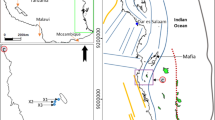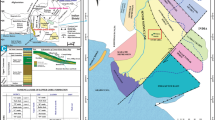Abstract
Reef-shoal gas reservoirs of Upper Permian Changxing Formation, which are the important targets for increasing gas reserve and production in Sichuan Basin, are highly heterogeneous in Eastern Sichuan Basin. However, because of the complex tectonic situation, the source and accumulation of natural gas are still being controversial. The lack of systematic research and relevant experimental analysis on controlling factors of hydrocarbon accumulation restrict the effective natural gas exploration. Based on petrographic observation, 3D seismic data and geochemistry, the reservoir spaces, fluid-inclusion of filling mineral, reservoir solid bitumen, and restoration of tectonic evolution are analyzed, which indicates that the reef-shoal gas reservoirs of Changxing Formation are fractured-vuggy type and formed mainly by dolomitization. The reservoir porosity system consists of pores, vugs, and fracture network. The gas reservoir boundary is mainly controlled by reef dolomite reservoirs distributed intermittently along the platform-margin. Both water and gas production wells have undergone two-stage accumulation process. The first stage is the crude oil charging of Wujiaping Formation from the Middle Jurassic to the early of the Late Jurassic; the second stage is that the crude oil of Wujiaping Formation was cracked into gas, accompanied with the formation of a large amount of reservoir bitumen from the middle-late of the Early Cretaceous to the middle of the Late Cretaceous. Tectonic-lithologic traps in both east and west side of the Kaijiang-Liangping Trough are formed in the late period of Indosinian. The faulting activity in the Yanshanian period, which gradually dropped in both east and west side of the Trough and slightly increases the tectonic-lithologic traps, is consistent with the peak period of hydrocarbon charging in the Wujiaping Formation source rock. The direct contact with the active fault above and damage to the regional caprock of the 4th member of Feixianguan Formation jointly result in the destruction of the reef-shoal gas reservoir in Changxing Formation. The Himalayan faulting activity, which further elevated the tectonic amplitude of tectonic-lithologic traps in both east and west side, forms the unique northwest–southeast strike faults in the east side of the Trough.











Similar content being viewed by others
References
Chen ZQ (2008) Changxing formation biohermal gas pools and natural gas exploration, Sichuan Basin. Pet Explor Dev 35(2):148–163. https://doi.org/10.3321/j.issn:1000-0747.2008.02.003
Dai JX (1992) Identification of various alkane gases. Science in ChinaSeries B-Chemistry 35(10):1246–1257. https://doi.org/10.1360/yb1992-35-10-1246
Deng Y, Hu GY, Zhao CY (2018) Geochemical characteristics and origin of natural gas in Changxing-Feixianguan Formations from Longgang Gasfield in the Sichuan Basin,China. Natural Gas Geoscience 29(6):892–907. https://doi.org/10.11764/j.issn.1672-1926.2018.03.016 (in Chinese)
Ding DG, Liu GX, Lǚ JX et al (2007) Progressive deformation of middle Paleozoic marine basins in the Yangtze plate, China. Geological Bulletin of China 26(9):1178–1188. https://doi.org/10.3969/j.issn.1671-2552.2007.09.019 (in Chinese)
Du CG, Wang JJ, Zhang J et al (2014) Structure and fluid transportation performance of faults in the Changxing-Feixianguan Formation, Xuanhan County, Northeastern Sichuan Basin. Acta Geologica Sinica - English Edition 88(3):865–877. https://doi.org/10.1111/1755-6724.12243
Feng C, Guo TL, Zou HY et al (2013) Enriched mechanism of natural gas in the Feixianguan-Changxing formations in the Northeast Sichuan Basin. Geoscience 27(4):907–914. https://doi.org/10.3969/j.issn.1000-8527.2013.04.017 (in Chinese)
Goldstein RH, Reynolds TJ (1994) Systematics of fluid inclusions in diagenetic minerals.Society for Sedimentary Geology (SEPM) Short Course, Tulsa
Guo TL (2011) Sequence strata of the platform edge in the Changxing and Feixianguan formations in the Yuanba area, northeastern Sichuan Basin and their control on reservoirs[J]. Acta Pet Sin 32(3):387–394. https://doi.org/10.7623/syxb201103003 (in Chinese)
Guo XS, Huang RC, Fu XY et al (2014) Gas accumulation and exploration direction of the Permian and Triassic reservoirs of reef-bank facies in Sichuan Basin. Oil & Gas Geology 35(3):295–302. https://doi.org/10.11743/ogg20140301 (in Chinese)
Guo C, Li GR, Wei HY et al (2016) Stratigraphic architecture and platform evolution of the Changxing Formation (Upper Permian) in the Yuanba Gas Field, northeastern Sichuan Basin, China. Arabian Journal of Geosciences 9:359. https://doi.org/10.1007/s12517-016-2348-3
Hao F, Guo TL, Zhu YM et al (2008) Evidence for multiple stages of oil cracking and thermochemical sulfate reduction in the Puguang gas field, Sichuan Basin, China. AAPG Bull 92(5):611–637. https://doi.org/10.1306/01210807090
Jiang YQ, Gu YF, Liu F, Liu DX et al (2017) Discovery and exploration significance of Zhongxian-Yuchi oceanic trough and platform margin, eastern Sichuan Basin, SW China. Acta Pet Sin 38(12):1343–1355. https://doi.org/10.7623/syxb20171200 (in Chinese)
Jiang YQ, Gu YF, Liu J et al (2018a) The evidence of hydrothermal activity and its significance of Permian-Triassic strata, eastern Longgang area, northeastern Sichuan Basin. Acta Sedimentol Sin 36(1):1–11. https://doi.org/10.3969/j.issn.1000-0550.2018.002 (in Chinese)
Jiang YQ, Gu YF, Xu C et al (2018b) Feixianguan Formation lithofacies zoning and its geological significance of eastern side of Kaijiang-Liangping Trough, NE Sichuan Basin. Natural Gas Geoscience 29(8):1067–1077. https://doi.org/10.11764/j.issn.1672G1926.2018.06.008 (in Chinese)
Jiang C, Gu YF, Zhang JW et al (2019) Multi-stage fluids charge and hydrocarbon accumulation of Changxing Formation reef reservoir in eastern Longgang area,NE Sichuan Basin. Natural Gas Geoscience 30(2):190–202. https://doi.org/10.11764/j.issn.1672G1926.2018.10.009 (in Chinese)
Le GY (1998) Tectonic characteristics and tectonic evolution of Dabashan orogenic belt and its foreland basin.Journal of. Mineral Petrol S1:14–21 (in Chinese)
Li ZQ, Ran LH, Chen GS et al (2002) Genetic geologic model and gas-bearing analysis of high and steep structures in east Sichuan. Journal of Chengdu University of Technology 29(6):605–609. https://doi.org/10.3969/j.issn.1671-9727.2002.06.003 (in Chinese)
Li GR, Wu HZ, Ye B et al (2014) Stages and mechanism of dissolution in Changxing reservoir, Yuanba area. Acta Petrologica Sinica 30(3):709–717 1000-0569/2014/030(03)-0709-17
Li WH, Zhang ZH, Zhang HM et al (2015) Hydrocarbon source and accumulation in Upper Triassic to Lower Jurassic in the Tongnanba area, northeastern Sichuan Basin. Arabian Journal of Geosciences 8:2515–2525. https://doi.org/10.1007/s12517-014-1403-1
Liu Y, Zhong NN, Chen JF et al (2013) Accumulation history of the Changxing-Feixianguan oil cracked gas reservoirs in northeastern Sichuan. Sci Sin Terrae 3(11):1819–1827
Long SX, Huang RC, Li HT et al (2011) Formation mechanism of the Changxing Formation gas reservoir in the Yuanba Gas Field, Sichuan Basin, China. Acta Geologica Sinica (English Edition) 85(1):233–242. https://doi.org/10.1111/j.1755-6724.2011.00393.x
Losh S, Eglinton L, Schoell M et al (1999) Vertical and lateral fluid flow related to a large growth fault, South Eugene island block 330 field, offshore Louisiana. AAPG Bulletin 83(2):244–276. https://doi.org/10.1306/00AA9A5C-1730-11D7-8645000102C1865D
Ma YS, Mu CL, Guo TL et al (2005) Sequence stratigraphy and reservoir distribution of the Changxing formation in northeastern Sichuan Basin. Earth Science Frontiers 12(3):179–185. https://doi.org/10.3321/j.issn:1005-2321.2005.03.019 (in Chinese)
Ma YS, Cai XY, Guo TL (2007) The controlling factors of oil and gas charging and accumulation of Puguang gas field in the Sichuan Basin. Chinese Science Bulletin 52(a01):149–155. https://doi.org/10.1007/s11434-007-6007-7
Ma YS, Cai XY, Zhao PR et al (2014) Characteristics and formation mechanisms of reef-shoal carbonate reservoirs of Changxing-Feixianguan formations,Yuanba gas field. Acta Petrolei Sinica 35(6):1001–1011. https://doi.org/10.7623/syxb201-106001 (in Chinese)
Pan LY, Shen AJ, Shou JF et al (2016) Fluid inclusion and geochemical evidence for the origin of sparry calcite cements in Upper permian Changxing reefal limestones, Eastern Sichuan basin (SW China). Journal of Geochemical Exploration 171:124–132. https://doi.org/10.1016/j.gexplo.2016.01.006
Shen WB, Pang XQ, Jiang FJ et al (2016) Accumulation model based on factors controlling Ordovician hydrocarbons generation, migration, and enrichment in the Tazhong area, Tarim Basin, NW China. Arabian Journal of Geosciences 9:347. https://doi.org/10.1007/s12517-016-2319-8
Wang YG, Wen YC, Zhang F, Yang Y, Zhang J (1998) Distribution law of the organic reefs in Changxing Formation of Upper Permian in East Sichuan. Natural Gas Industry 18(6):10–15 (in Chinese)
Wang ZC, Zou CN, Tao SZ et al (2004) Analysis on tectonic evolution and exploration potential in Dabashan foreland basin. Acta Petrolei Sinica 25(6):23–28. https://doi.org/10.3321/j.issn:0253-2697.2004.06.005 (in Chinese)
Wang ZC, Zhao WZ, Xu AN et al (2006) Structure styles and their deformation mechanisms of Dabashan foreland thrust belt in the north of Sichuan Basin. Geoscience 20(3):429–435. https://doi.org/10.3969/j.issn.1000-8527.2006.03.010 (in Chinese)
Wen HG, Zhou G, Zheng RC et al (2017) The sedimentation-diagenesis-reservoir formation system of reef dolomites from Changxing Formation in the Eastern of Kaijiang-Liangping platform-shelf, Sichuan Basin. Acta Petrologica Sinica 33(4):1115–1134 1000–0569/2017/033(04)-1115–34
Xu SC, Li GR, Zhang XQ et al (2017) Genetic mechanism of reefal dolostones of the Changxing Formation in Yuanba area, northeastern Sichuan Basin. Oil & Gas Geology 38(4):729–740. https://doi.org/10.11743/ogg20170410 (in Chinese)
Zhang ZL, Wang H, Yang H (2000) Study on passage system of petroliferous basins. Oil & Gas Geology 21(2):133–135. https://doi.org/10.3321/j.issn:0253-9985.2000.02.010 (in Chinese)
Zhang JY, Liu WH, Teng GE et al (2010) Characteristics of Natural Gas in P2ch—T1f Layers in Jiannan Gas Field and Gas Source Correlation. Natural Gas Geoscience 21(6):1004–1013. https://doi.org/10.3969/j.issn.1003-5400.2014.10.181 (in Chinese)
Zhou L, Li D, Wu Y et al (2017) The seismic response characteristics and distribution of the reefs in the Changxing Formation, Northern Sichuan Basin. Acta Petrologica Sinica 33(4):1189–1203 CNKI:SUN:YSXB.0.2017–04-013
Zhu GY, Zhang SC, Liang YB et al (2006) The characteristics of natural gas in Sichuan Basin and its sources. Earth Science Frontiers 13(2):234–248. https://doi.org/10.3321/j.issn:1005-2321.2006.02.022 (in Chinese)
Zhu YM, Li Y, Hao F et al (2012) Compositional characteristics and origin of marine and terrestrial solid reservoir bitumen in the Northeast Sichuan basin. Acta Petrologica Sinica 28(3):870–878. https://doi.org/10.2110/palo.2011.p11-036r
Zou CN, Xu CC, Wang ZC et al (2011) Geological characteristics and forming conditions of the large platform margin reef-shoal gas province in the Sichuan Basin. Petroleum Exploration and Development 38(6):641–651. https://doi.org/10.1016/s1876-3804(12)60001-9
Acknowledgments
The authors express their deep gratitude to Xiaohua Lei for his help during the research. We are also grateful to the reviewers for their valuable suggestion.
Funding
This research was supported jointly by the National Natural Science Foundation of China (41972165), National Natural Science Foundation of China (41430316), National Science and Technology Major Project (Grant No. 2016ZX05052), and National Science and Technology Major Project (Grant No. 2016E-0607).
Author information
Authors and Affiliations
Corresponding author
Additional information
Responsible Editor: Santanu Banerjee
Rights and permissions
About this article
Cite this article
Gu, Y., Jiang, Y., Fu, Y. et al. Hydrocarbon accumulation and main controlling factors of reef-shoal gas reservoirs in Changxing Formation in the complex tectonic area, Eastern Sichuan Basin. Arab J Geosci 12, 776 (2019). https://doi.org/10.1007/s12517-019-4922-y
Received:
Accepted:
Published:
DOI: https://doi.org/10.1007/s12517-019-4922-y




